
 |
|
March 2017 News from No BoundariesUpcoming TRB Webinar to Feature No Boundaries | 2017 TRB Annual Meeting Maintenance Papers | New Members Are Welcome Around the Maintenance World Meetings and Events | Training Opportunities | Research |
The No Boundaries Roadway Maintenance Practices pooled fund project, #TPF-5(330), facilitates the implementation of proven, ready-to-deploy maintenance innovations. |
| Welcome! This newsletter from the national No Boundaries consortium features the latest updates on the group's activities and compiles recent research, state practices, and training opportunities related to non-winter roadway maintenance from around the country. |
News from No Boundaries |
| Upcoming TRB Webinar to Feature No Boundaries
Participants should register in advance of the webinar. There is no attendance fee for employees of state DOTs and other TRB sponsor organizations, and 1.5 professional development hours can be earned by attending. |
|
|
|
|
| For the second year, No Boundaries has compiled and published a compendium of maintenance-related papers from the Transportation Research Board Annual Meeting. |
|
|
| New Members Are Welcome No Boundaries is Transportation Pooled Fund project #TPF-5(330). State DOT commitments to the project can be made using 100% federal funds. Contact Brian Hirt, CTC & Associates, at 402-770-9067 for more information. |
|
|
 |
Meetings and Events |
| Date | Meeting / Event | Location |
| April 3-6 | Austroads Bridge Conference, "Bridges: Connecting Communities" | Melbourne, Australia |
| April 10-12 | Southeast Bridge Preservation Partnership Annual Meeting | Charleston, West Virginia |
| April 25-27 | 11th TRB International Bridge and Structure Management Conference | Mesa, Arizona |
| April 25-27 | Southeast Pavement Preservation Partnership Annual Meeting | Montgomery, Alabama |
| May 8-10 | Northeast Pavement Preservation Partnership Annual Meeting | Portland, Maine |
| May 22-24 | Western Bridge Preservation Partnership Annual Meeting | Denver, Colorado |
| May 23-24 | 2017 Florida DOT Maintenance Conference | Kissimmee, Florida |
| May 24 | National Road Research Alliance Pavement Conference | St. Paul, Minnesota |
| June 12-16 | World Conference on Pavement and Asset Management | Baveno, Italy |
| August 21-22 | 9th New York City Bridge Conference (Bridge Engineering Association) | New York City |
| August 28-30 | Midwestern Pavement Preservation Partnership Annual Meeting | Traverse City, Michigan |
| September 11-13 | Northeast Bridge Preservation Partnership Annual Meeting | New Brunswick, New Jersey |
| September 26-27 | 2017 University Transportation Centers Spotlight Conference: Rebuilding and Retrofitting the Transportation Infrastructure | Washington, D.C. |
| October 23-25 | Rocky Mountain West Pavement Preservation Partnership Annual Meeting | Seattle, Washington |
| November 6-8 | Midwest Bridge Preservation Partnership Annual Meeting | Minneapolis, Minnesota |
| July 14-17, 2018 | 12th TRB National Conference on Transportation Asset Management | San Diego, California |
To recommend a maintenance-related conference or meeting for this calendar (including state and local events), please email Brian Hirt with details and a link to the event website. |
||
Training Opportunities |
| Maintenance and Roadway Operations Workshop The International Bridge, Tunnel and Turnpike Association will hold its 2017 Maintenance and Roadway Operations Workshop May 21-23 in New Orleans. The maintenance track of educational presentations will include sessions on asset management in bridge and tunnel maintenance, work zone safety, and innovation and technology in maintenance. The workshop will also include general sessions, a roadway operations track, technical tours and an exhibit hall. |
 |
|
|
|
Asset Management Research |
| Pavement Management Systems: Putting Data to Work Pavement management systems can help agencies optimize the use of their available funding, communicate funding needs, and objectively manage their pavement network. This synthesis identified current pavement management practices used at state and provincial transportation agencies, particularly for use in resource allocation, analyzing the cost-effectiveness of treatments, program development, and communication with stakeholders. The project found that most agencies develop customized pavement deterioration models and treatment rules using such data variables as pavement type, functional condition, highway system, treatment history and traffic data. Report. |
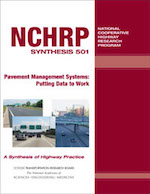 |
|
|
|
| Framework for a Pavement-Maintenance Database System This project developed a framework for a pavement maintenance database, including a uniform format for collecting, reporting and storing information on pavement maintenance activities. A common framework would promote compatibility of maintenance data reported by different agencies and could provide an effective way to use data in cost-benefit analysis. The report includes a DVD that contains the pavement maintenance database and a CD that contains sample data; both can be downloaded as ISO images. Report. |
 |
|
|
|
| Element Level Bridge Inspection: Benefits and Use of Data for Bridge Management The Moving Ahead for Progress in the 21st Century Act (MAP-21) requires the collection and submission of element-level bridge inspection data for all National Highway System bridges. This project used a survey of Indiana DOT peer agencies and a review of literature and bridge inspection guides to develop recommendations for element-level bridge inspection techniques, data collection, and inspector training. The study found that while data required by the Federal Highway Administration is sufficient in the short term, INDOT's inspection program should be expanded over time to make it more useful. Additionally, a rigorous training program with detailed quality control procedures will be needed to ensure data reliability. Report. |
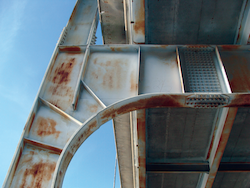 |
|
|
|
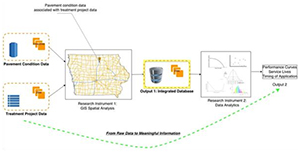 Historical Performance Evaluation of Iowa Pavement Treatments Using Data Analytics Iowa's pavement network has reached maturity, making maintenance and rehabilitation more important than new construction. Iowa DOT needed to evaluate the performance of maintenance and rehabilitation activities to better predict their impacts and support cost-effective decision-making. Pavement condition data is stored in Iowa DOT's geographic information system, but not in a format compatible with the department's preservation and rehabilitation data. To integrate the two databases, this project used GIS tools and methods including the department's linear referencing system to compare pavement conditions before and after treatments. The project found that rutting and International Roughness Index are the most consistent performance indicators and made several recommendations to maximize the benefits of collected data. Report. |
|
|
 Benchmarking the Operations and Maintenance of New Zealand's Roading Sector Transportation agencies sometimes have to determine appropriate levels of investment for maintenance and operations of their infrastructure without having adequate information to make that determination. Using benchmark data from similar agencies can help to clarify what constitutes an appropriate investment, and help better understand the overall performance of complex systems like highway maintenance. This project documented existing benchmarking methodologies used in New Zealand and around the world and evaluated best practices, opportunities, and barriers and risks in benchmarking. A value-for-money equation originally developed for not-for-profit organizations has also worked well for highway maintenance, and Data Envelopment Analysis was found to be helpful in normalizing for unique characteristics. Report. |
|
|
| Migration Probability Matrix for Bridge Element Deterioration Models Transportation agencies are required to develop transportation asset management plans that feature life cycle cost analysis for bridges, including deterioration models. No DOTs yet have sufficient element inspection data to support this deterioration modeling. This project, conducted for Florida DOT, suggested a readily implementable migration probability matrix that encapsulates the differences between Florida's bridge element inspection data gathered under AASHTO's 1998 Guide to Commonly Recognized Structural Elements and data gathered using Florida's 2016 inspection manual. This matrix can be used to adjust deterioration models developed using the older data to make it compatible with inspection data gathered under the new manual. Conference paper. |
|
|
|
|
Bridge Repair and Rehabilitation Research |
| Continuous Long-Term Health Monitoring Using Ultrasonic Wave Propagation Reinforced concrete bridge decks are exposed to harsh loading and environmental conditions, making them susceptible to deterioration. Delamination is a common flaw caused by chloride salts, moisture and oxygen in the environment. DOTs commonly use a variety of non-destructive techniques to detect delamination in bridge decks, but this practice is only used to detect existing delamination. This project investigated whether ultrasonic wave propagation and a specific sensor arrangement can monitor and identify the onset of delamination, which could detect delamination before serious problems develop. Experimental results demonstrated the feasibility and reliability of the approach, and a follow-up project will work to expand the application of the method and make it practical for widespread implementation. Report. |
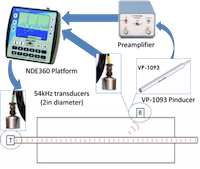 |
|
|
|
| Climate Change Impact on Management of Deteriorating Bridges: A Case Study of U.S. Midwest Region Many reinforced concrete bridges in the United States are at least 50 years old and suffering degradation due to environmental stressors. While this deterioration has been studied, environmental parameters such as temperature, humidity and precipitation have changed due to climate change effects. This project investigated the impact of climate change on the deterioration of reinforced concrete bridges in the Midwest, including its role in altering the frequency and intensity of extreme events such as floods. Conference paper. |
|
|
|
|
| Long-Term Maintenance of the Anthony Wayne Suspension Bridge Main Cables The Anthony Wayne Bridge, the only suspension bridge in Ohio, is undergoing a significant rehabilitation. Acoustic emission sensors to monitor the condition of the bridge's cables have already been installed, and a dehumidification system will be installed. This project investigated the potential use of the Analatom AN110 corrosion sensor on the bridge to measure corrosion rates in real time. Tests found that the sensor can consistently record changes in corrosion due to changes in the environment to ensure that dehumidification proceeds as expected. Report. |
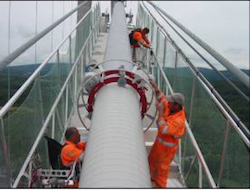 |
|
|
|
Culvert Maintenance Research |
| Using Remote Data Collection to Identify Bridges and Culverts Susceptible to Blockage During Flooding Events When debris blocks culverts and bridges, it can cause flooding at lower flow volumes than predicted by floodplain delineations. This project pilot-tested the use of an unmanned aerial vehicle to gather stereo imagery of streambeds upstream of crossing structures and developed a process to rapidly transmit that information via email or text message. The UAV can be rapidly deployed and output data can be provided in less than 48 hours, which makes it suitable for high-risk crossings. Report. |
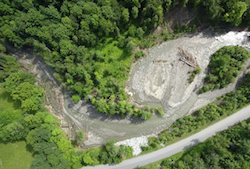 |
|
|
|
Emergency Maintenance Operations Research |
| Post-Extreme Event Damage Assessment and Response for Highway Bridges This synthesis reviews procedures used by state and local transportation departments to assess damage to bridges in response to extreme events, including earthquakes, landslides, hurricanes, floods, truck crashes and terrorist attacks. Collisions, primarily caused by over-height vehicles, were the most common source of bridge failure, followed by failures caused by hydraulic sources such as scour or flood and debris flow. All agencies surveyed for the synthesis reported using visual inspection as the first tool when assessing bridge damage, with nondestructive testing commonly used as a secondary approach to better locate and measure damage. The synthesis found that most states have emergency response plans for extreme events, but not all of those plans are tailored for response to bridge damage. Report. |
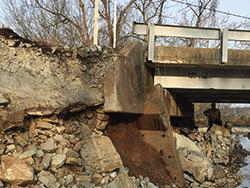 |
|
|
|
Funding and Budgeting Research |
| Development of a Cost Index for In-House Roadway Maintenance Work for the North Carolina Department of Transportation A cost index that represents how maintenance costs change over time is useful to transportation agencies for developing work plans and budgets over multiple years. FHWA's Highway Maintenance and Operations Cost Index was discontinued in 1990, and since then, state transportation agencies have had to use available cost indices that are not specific to roadway maintenance. This project developed cost indices for North Carolina DOT representing in-house maintenance in the Roadside, Maintenance, Traffic and Bridge categories of the maintenance budget and then combined them into a composite index. The methodology should overcome the limitations of FHWA's previous index, including the number of tasks included, outdated units of measure, and lack of guidance about goods and tasks included. Conference paper. |
|
|
|
|
Pavement Repair and Rehabilitation Research |
| Systems Preservation Guide: A Planning Process for Local Government Management of Transportation Networks Local agencies are facing severe challenges in keeping roads safe and in good repair, including aging infrastructure, increasing material costs, and stagnant or decreasing funding levels. Some local governments have considered unpaving roads, but this is only one solution and likely to be unpopular except as a last resort. This project developed an interactive resource guide, including research, tools, and strategies to help local agencies communicate transportation system preservation needs to elected officials and the public. The guide helps agencies define their preservation needs, select preservation strategies, select communication strategies, and review lessons learned from pilot counties in Minnesota. Report. |
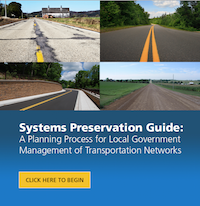 |
|
|
|
| Ranking of Pavement Preservation Practices and Methods Pavement preservation represents a proactive approach to maintaining road networks. This project sought to identify methods to improve the implementation of pavement preservation strategies on asphalt roadways in South Carolina, with particular attention paid to pavements in the Non-Federal Aid secondary system. Recommendations to help improve the state's roadway health include methods to identify pavement sections that are candidates for preservation activities, a local-level pavement evaluation system, a preservation treatment selection support tool, a methodology for tracking treatments to support future benefit-cost analysis, and training materials for DOT personnel. Report. |
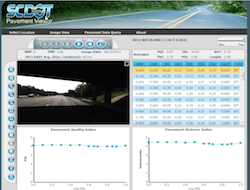 |
|
|
|
 Preventing Transverse Bumps and Cracks in New Asphalt Overlays Over Crack Sealants Crack sealing is a common method for preserving asphalt pavements by preventing water intrusion into the pavement foundation. However, hot-mix asphalt overlays placed on top of pavements containing crack sealants sometimes develop bumps and transverse cracking. This five-year project sought to identify factors related to the appearance of these bumps and cracks. Researchers found that vibratory breakdown rolling, pavement gradients, sealant geometry, tack coat application rate and tack coat adhesivity are the factors that most contribute to the occurrence of bumps and transverse cracks during overlay construction. Additional observations suggest that bumps and cracks are proportional to the size of the "bow wave" of asphalt in front of the breakdown roller, which is dependent on mixture properties, roller size, speed, vibration characteristics, and pavement gradient. Report. |
|
|
| Performance-Related Specifications for Emulsified Asphaltic Binders Used in Preservation Surface Treatments The properties of the asphaltic binder used in a pavement preservation surface treatment are important to the treatment's performance. In practice, however, binders are often selected based on availability rather than performance. This project produced recommended emulsion performance grade specifications for emulsions used in chip seals, microsurfacing, and spray seals. It also evaluated tests of binder properties and developed test protocols for properties for which test methods previously were not available. Report. |
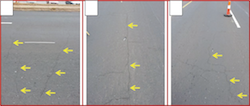 |
|
|
|
| Algorithm and Software for Proactive Pothole Repair Typically, when potholes appear in pavement, a repair crew is dispatched to patch the hole intending that the patch will last until a more permanent repair can be made. This reactive approach means that potholes are often repaired too late to prevent further damage, and it results in inefficient deployment of repair crews. This study investigated the relation between traffic loads, winter weather records, and the number of potholes requiring patching to attempt to develop a model to predict pothole formation. The research showed that traffic loads are more important to the formation of potholes on interstate highways than urban US highways and urban and rural state routes, but that temperature is more important than traffic loads on rural routes. While the findings are encouraging, the project did not produce implementable results. Report. |
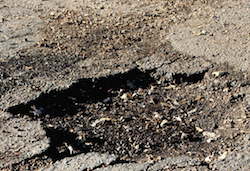 |
|
|
|
| Chicago's Lake Shore Drive: A Case Study for Rapid Response to Blowups and Concrete Joint Investigation Lake Shore Drive is one of Chicago's major thoroughfares and is composed of jointed plain concrete pavement with epoxy-coated dowel bar reinforcement in the transverse joints. Extreme weather exposure and aging pavement has led to multiple pavement failures. This project formulated and oversaw a repair procedure to eliminate further distresses and restore long-term ride quality and structural stability while meeting the city's logistical constraints for traffic closures. Using a patching material containing stone matrix asphalt with fractionated recycled asphalt product, recycled asphalt shingles, and ground-tire rubber was found to be a sustainable approach that would stand up to the highway's long-term environmental and traffic demands. Conference paper. |
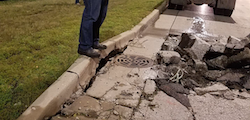 |
|
|
|
| Development of Recommended Guidelines for Preservation Treatments for Bicycle Routes This project was a follow-up to a previous study that evaluated the effects of pavement macrotexture on bicycle ride quality. This study included a wider range of riders and bicycle types, considered roughness and distresses, and included measurements on urban streets, state highways, and county roads. Findings included that changes in Caltrans' chip seal gradation specifications resulted in higher macrotexture values; that most slurry seals on city streets produced high acceptability rates; and that the presence of distresses (particularly cracking) lowers the ratings that riders give to pavements. Report. |
 |
|
|
|
Subscribe to this newsletter |